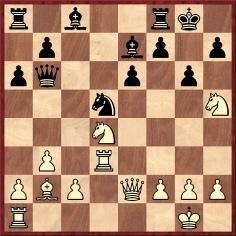
Edward Winter
The meaning of en prise is obvious and easy to explain, or is it? English-language dictionaries give simple but serviceable definitions, such as ‘Exposed to capture’ and ‘In a position to be taken’, but some chess books aim for more and achieve less. From page 102 of Chess Thinking by Bruce Pandolfini (New York, 1995):
‘En Prise: “In take.” A French term indicating an undefended unit in position to be captured.’
En prise does not mean ‘in take’ because ‘in take’ does not mean anything. Nor can it be regarded as indicating a unit (defended or undefended).
Page 55 of Chess: How to Improve Your Technique by Frank Brady (New York, 1974) was no more successful:
‘En Prise: a French expression meaning ‘in taking’ – when a piece or a pawn is under direct attack and is left unprotected, it is said to be en prise (pronounced en-pree).’
‘In taking’ and ‘unprotected’ are as inappropriate as Brady’s pronunciation guide (since prise rhymes, more or less, with ‘keys’).
Yet even some prominent authorities have disagreed about what the term signifies. In Harry Golombek’s The Encyclopedia of Chess (London, 1977) the entry for ‘en prise’ (written by H.G. himself) stated:
‘When a player unintentionally places a piece where it may be captured, then he is said to put the piece en prise.’
The word ‘unintentionally’ was then disputed by W.H. Cozens but defended by a contributor to the Encyclopedia, Wolfgang Heidenfeld. (For their discussion, see the BCM, September 1978, page 402; April 1979, page 175; July 1979, page 311.) After all that, Golombek dropped ‘unintentionally’ from the paperback edition of his Encyclopedia, although the word (and much else besides) was the subject of an unwise reprise in Nathan Divinsky’s desperate and desperately imitative 1990 volume The Batsford Encyclopedia of Chess.
Finally, a little-known game to illustrate the theme:
Theodor Gerbec – J. Schenkein
Trebitsch tournament, Vienna, 1929-30
French Defence
1 e4 e6 2 d4 d5 3 Nc3 dxe4 4 Nxe4 Nf6 5 Ng3 Be7 6 Nf3 Nbd7 7 Bd3 a6 8 O-O c5 9 Qe2 cxd4 10 Nxd4 Nc5 11 Rd1 Nxd3 12 Rxd3 Qb6 13 b3 O-O 14 Bb2 Nd5 15 Nh5 g6

(Leaving his knight at h5 en prise, White puts his other knight en prise to two pawns.) 16 Nf5 exf5 17 Rxd5 Bg5 18 Rad1 gxh5 19 Rd6 Qc7 20 Qxh5 Qe7 21 h4 Bf4 22 Bf6 Qe4 23 g3 Be6 24 gxf4 Qxf4 25 R6d4 Resigns.
Source: Tidskrift för Schack, April 1930, pages 80-81, which gave the game with brief notes by G. Stoltz.
(3332)
A further example:
C.T. Shedden – E.H. Bermingham
Correspondence game, 1911
Bishop’s Opening
1 e4 e5 2 Bc4 Nf6 3 d3 Bc5 4 Nc3 d6 5 f4 Ng4 6 g3 Nf2 7 Qh5 g6 8 Qh6 Nxh1 9 f5 Nd7 10 Bg5 f6 11 Qg7 Rf8 12 Nd5 fxg5 13 fxg6 c6 14 gxh7 cxd5
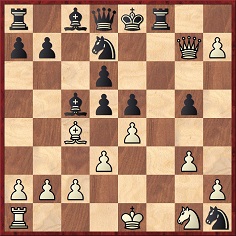
15 Qg6+ (‘Three pieces down and two others en prise.’) 15...Ke7 16 Bxd5 Nf6 17 Qg7+ Ke8 18 h8(Q) Qe7 19 Qxe7+ Kxe7 20 Qg7+ Ke8 21 Bb3 Bxg1 22 Kd2 Nxe4+ 23 dxe4 Rf2+ 24 Ke1 Rxh2 25 Ba4+ Kd8 26 Qxg5+ Kc7 27 Qe7+ Kb6 28 Qxd6+ Ka5 29 a3 Bf2+ 30 Kd1 Bg4+ 31 Kc1 b6 32 Qb4+ Ka6 33 Bc6 Resigns.
Source: BCM, December 1911, page 462. The magazine wrote: ‘Rarely have we seen such a series of offered sacrifices as in this spirited encounter.’
(2147)
From the Wiener Schachzeitung, April 1926, pages 106-107, a position from the Spielmann-Janowsky game at the Semmering tourney of that year:
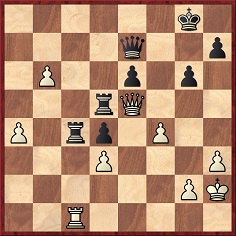
White played 37 b7, putting everything en prise. The other point of interest is the continuation, a rare example of two queens against a queen and two rooks:
37...Rxc1 38 b8(Q)+ Rd8 39 Qb6 Kf7 40 a5 Rcc8 41 f5 gxf5 42 a6 Rd5 43 Qf4 Rd7 44 Qb3 Ke8 45 Qe5 Rd5 46 Qh8+ Kd7 47 Qb7+ Rc7 48 Qhc8+ Kd6 49 Qb6+ Resigns.
(697)
A strange game occurred between P.S. Leonhardt and E. Znosko-Borovsky in Ostend on 27 June 1906:
1 f4 d5 2 e3 c5 3 Bb5+ Nc6 4 Nf3 Bd7 5 b3 e6 6 Bb2 Nf6 7 O-O Bd6 8 Nc3 a6 9 Bxc6 Bxc6 10 Ne2 Qe7 11 Ne5 Bxe5 12 fxe5 Ng4 13 h3 Nh6 14 Qe1 O-O 15 g4 Qg5 16 Kh2 Rad8 17 Rf4 d4 18 exd4 cxd4 19 Ba3 d3 20 cxd3 Qxe5 21 Bxf8 Kxf8 22 Kg1 Rxd3
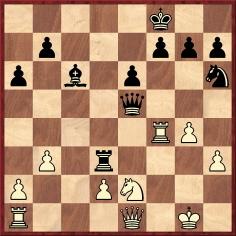
Now White, in time pressure, put his queen en prise, but Black overlooked 23…Qxe1+ (with mate next move).
23 Nc1 Qxf4 24 Nxd3 Qf3 25 Nf4 Qxf4 26 White resigns.
Source: La Stratégie, 20 September 1906, page 276.
(Kingpin, 2000)
The mispronunciation of en prise seems particularly prevalent in United States sources, as a web search for ‘on pree’ will show. As regards chess books, the most recent occurrence of this error that we have seen is on page 167 of Portable Chess Coach by Judee Shipman (New York, 2006).
As usual, the Collins English Dictionary is impeccable:

From an article ‘Tsoogtsvahng and All That’ by Burt Hochberg on pages 350-351 of the June 1972 Chess Life & Review:
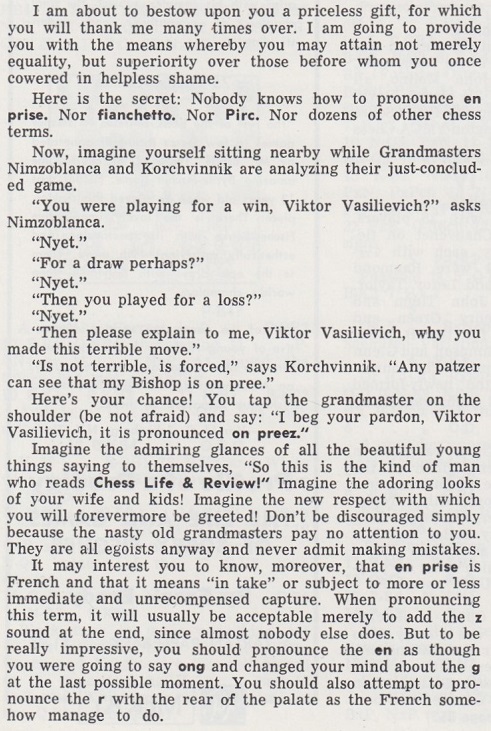
(9112)
See C.N. 3205 (Chess Jottings) and C.N. 3565 for a discussion of a magazine edited by Daniel Fiske entitled Í Uppnámi (which is Icelandic for en prise).
To the Chess Notes main page.
To the Archives for other feature articles.
Copyright: Edward Winter. All rights reserved.